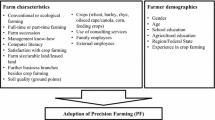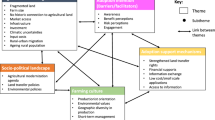Abstract
The adoption of precision farming (PF) was studied on the basis of personal interviews conducted at several agricultural exhibitions in Germany. Between 6.65% and 11% of the interviewed farmers used PF. The majority used data collection techniques such as GPS-based area measurement and soil sampling rather than variable rate application techniques such as site-specific sowing and fertilising. Roughly half the farmers interviewed knew about PF. About 7–10% of them intended to start using PF in the future. The results indicated that a large number of farmers did not even know what PF meant. In order to get more insight into this situation, several interviews were conducted with farmers already using PF techniques. A further study in 2005 of PF education in Germany indicated that, especially at vocational and technical schools, the subject was only covered to a small extent although the aim was to give a better coverage in future. At higher education levels, such as at universities and technical colleges, the teaching of PF was clearly better established. In order to promote awareness of PF among farmers, information and teaching materials adapted to the relevant educational levels were developed and tried out at training events. The main topics addressed were parallel tracking systems, site-specific nitrogen fertilising, yield mapping in grain production and the use of PDAs in crop farming. Finally, preliminary survey results are presented showing how knowledge about PF can best lead to its adoption and transfer into daily practice.


Similar content being viewed by others
References
Ajzen, I. (1991). The theory of planned behaviour. Organizational Behavior and Human Decision Processes, 50, 179–211. doi:10.1016/0749-5978(91)90020-T.
Arnholt, M., Batte, T. M., & Prochaska, S. (2001). Adoption and precision farming technologies: A survey of central Ohio precision farmers. AEDE-RP-0011-01, agricultural, environmental and development economics (p. 15). Columbus, USA: Ohio State University.
Aschenbrenner, G., Boxberger, J., & Krönigsberger, O. (2003). Elektronikeinsatz in der Landwirtschaft (The application of electronics in agriculture). ÖKL-Booklet 221 Vienna, Austria.
Atteslander, P. (2006). Methoden der empirischen Sozialforschung (Methods of empirical social research) (pp. 121–139). Berlin, Germany: Erich Schmidt Verlag.
Batinic, B., Haupt, C. M., & Wieselhuber, J. (2006). Validierung und Normierung des Fragebogens zur Erfassung von Trendsetting (TDS) (Validation and standardisation of the construction of the trendsetting questionnaire (TDS)). Diagnostica, 52, 60–72. doi:10.1026/0012-1924.52.2.60.
Blackmore, S., Godwin, R., & Fountas, S. (2003). The analysis of spatial and temporal trends in yield map data over six years. Biosystems Engineering, 84(4), 455–466. doi:10.1016/S1537-5110(03)00038-2.
Blackmore, S., Griepentrog, H. W., Pedersen, S. M., & Fountas, S. (2006). Europe. In A. Srinivasan (Ed.), Handbook of precision agriculture (pp. 567–607). New York, USA: The Haworth Press.
D_Statis. (2006). Landwirtschaft in Deutschland und in Europäischen Union 2006 (Agriculture in Germany and in the European Union 2006). (Ed.) Statistisches Bundesamt (Federal Statistics Office), Wiesbaden, Germany. Retrieved Aug 11, 2008, from www.destatis.de.
Daberkow, S. G., & McBride, W. D. (2003). Farm and operator characteristics affecting the awareness and adoption of precision agriculture technologies in the US. Precision Agriculture, 4, 163–177.
de Baey-Ernsten, H. (2003). Agrartechnik—von der Hacke zur satellitengesteuerten Hightech-Maschine (Agricultural mechanisation—from the hoe to satellite navigated hi-tech machinery). Forum TTN—Fachzeitschrift des Instituts Technik-Theologie-Naturwissenschaften an der Universität München (Forum TTN—Journal of the Institute Technology–Theology–Natural Sciences (TTN) at the Ludwig-Maximilian University of Munich), H9, 17–47. (ISSN 1438-0773, ISBN 3-89675-949-3).
Demel, J. (2006). Qualifizierte Ausbildung in der Landwirtschaft wird immer wichtiger. Statistisches Monatsheft Baden-Württemberg (Qualified training in agriculture is increasingly important. Baden-Württemberg statistical monthly report) Retrieved Aug 12, 2008, from http://www.statistik.baden-wuerttemberg.de/Veroeffentl/Monatshefte/PDF/Beitrag06_09_04.pdf.
Doluschitz, R., & Jungbluth, T. (2004). Precision Agriculture––Notwendigkeit, Stand der Technik und Perspektiven (Precision agriculture––requirements, current state of the technology and perspectives). Bildung & Beratung Agrar, 5, 166–170.
Drangmeister, H. (2007). Einsatz von PDAs in der Außenwirtschaft (Application of palm computers in agriculture outdoors). KTBL-Heft 69. Darmstadt, Germany: Kuratorium für Technik und Bauwesen in der Landwirtschaft.
Fink, K., & Kosecoff, J. (2006). How to conduct surveys a step-by-step guide (pp. 31–43). California, USA: SAGE Publications Thousands Oaks.
Fountas, S., Blackmore, S., Ess, D., Hawkins, S., Blumhoff, G., Lowenberg-Deboer, J., et al. (2005). Farmers experience with precision agriculture in Denmark and the US Eastern Corn Belt. Precision Agriculture, 6(2), 121–141.
Gumpertsberger, E., & Jürgens, C. (2003). Acceptance of precision agriculture in Germany—results of a survey in 2001. In J. Stafford & A. Werner (Eds.), Proceedings of the 4th European conference on precision agriculture (pp. 259–264). The Netherlands: Wageningen Academic Press.
Habermehl, W. (1992). Angewandte Sozialforschung (Applied social research) (pp. 157–188). Oldenbourg Wissenschaftsverlag GmbH: München, Germany.
Hufnagel, J., Herbst, R., Jarfe, A., & Werner, A. (2004). Precision farming––Analyse, Planung, Umsetzung in die Praxis (Precision farming––analysis, planning, implementation in practical farming). KTBL-Schrift 419. Darmstadt, Germany: Kuratorium für Technik und Bauwesen in der Landwirtschaft.
Hüter, J., & Klöble, U. (2007a). Precision Farming in der Praxis—Technik und Anwendungsmöglichkeiten (Precision farming in practical agriculture—equipment and application possibilities). Power point presentation on CD, Kuratorium für Technik und Bauwesen in der Landwirtschaft (KTBL), Darmstadt, Germany. Retrieved Dec 12, 2008, from http://daten.ktbl.de/user/slides/intialize.html;jsessionid=2CF582E08FE74672D3B4B6AC46746730.
Hüter, J., & Klöble, U. (2007b). Fachlehrer informieren sich über Precision Farming (Specialised teachers learn about precision farming). Bildung & Beratung agrar 05/07, p. 163.
Hüter, J., Kloepfer, K., & Klöble, U. (2005). Elektronik, Satelliten und Co.—Precision Farming in der Praxis (Electronics, satellites and more—precision farming in practical agriculture), KTBL-Heft 52. Kuratorium für Technik und Bauwesen in der Landwirtschaft, Darmstadt: Germany.
Kutt, K. (2001). Den Transfer gestalten. Aber wie? Für eine bessere Umsetzung von Modellversuchsergebnissen durch ein „Management” des Transfers. (Achieving the transfer. But how? Implementation of the results of model experiments through “management” of transfers). Berufsbildung in Wissenschaft und Praxis, 30(2), 28–32.
Niemann, H., Schwaiberger, R., & Fröba, N. (2007). Parallelfahrsysteme (Tracking systems). KTBL-Heft 67. Darmstadt, Germany: Kuratorium für Technik und Bauwesen in der Landwirtschaft.
Noack, P. O. (2007). Ertragskartierung im Getreidebau (Yield mapping in grain production). KTBL-Heft 70. Darmstadt, Germany: Kuratorium für Technik und Bauwesen in der Landwirtschaft.
Pedersen, S. M., Ferguson, R. B., & Lark, M. (2001). A comparison of producer adoption of precision agriculture practices in Denmark, the United Kingdom and the United States. SJFI–Working Paper no. 2/2001. Danish Institute of Agricultural and Fisheries Economics, Farm Management and Production Systems Division, Denmark, 40 pp.
Pedersen, S. M., Fountas, S., Blackmore, B. S., Gylling, M., & Pedersen, J. L. (2004). Adoption and perspective of precision farming in Denmark. Acta Scandinavica Section B–Soil and Plant Science, 54(1), 2–8.
Probst, G., Raub, S., & Romhardt, K. (1999). Wissen managen: Wie Unternehmen ihre wertvollste Ressource optimal nutzen (Managing knowledge: how businesses optimally use their most valuable resource). Frankfurter Allgemeine Zeitung Verlag, Frankfurt. Wiesbaden, Germany: Gabler Verlag.
Reckleben, Y., et al. (2007). Teilflächenspezifische Stickstoffdüngung (Site-specific nitrogen fertilising). KTBL-Heft 75. Darmstadt, Germany: Kuratorium für Technik und Bauwesen in der Landwirtschaft.
Reichardt, M., & Jürgens, C. (2007). Adoption and perspective of precision farming (PF) in Germany—results of several surveys among the different agricultural target groups. In J. V. Stafford (Ed.), Precision agriculture 2007: Proceedings of the 6th European conference on precision agriculture (pp. 843–850). The Netherlands: Wageningen Academic Publishers.
Reichardt, M., & Jürgens, C. (2009). Adoption and future perspective of precision Farming in Germany: results of several surveys among different agricultural target groups. Precision Agriculture, 10(1), 73–94.
Schmitz, M., Martini, D., Kunisch, M., & Mösinger, H.-J. (2007). Enabling standardized, platform-independent internet data exchange in farm management information systems. Retrieved Aug 22, 2008, from http://infolab-dev.aua.gr/mtsr07/papers/MTSR07_AgriculturalSession_Schmitz_etal.pdf.
Schnell, R., Hill, P., & Esser, E. (2005). Methoden der empirischen Sozialforschung (Methods of empirical social research). Oldenbourg Wissenschaftsverlag GmbH (pp. 319–388). München, Germany.
Sørensen, C. G., Fountas, S., Pedersen, H. H., & Blackmore, S. (2002). Information sources and decision making on precision farming. In Proceedings of the 6th international conference on precision agriculture and other precision resources management (CD-ROM). Madison, WI, USA: ASA-CSSA-SSSA.
Swinton, S. M., & Lowenberg-Deboer, J. (2001). Global adoption of precision agriculture technologies: Who, when and why. In G. Grenier & S. Blackmore (Eds.), Precision agriculture 2001: Proceedings of the 3rd European conference on precision agriculture (pp. 557–562). AgroMontpellier, France.
Venkatesh, V., & Davis, F. D. (2000). A theoretical extension of the technology acceptance model: Four longitudinal field studies. Management Science, 46, 186–204.
Acknowledgement
This project was carried out through sub-projects “Acceptance” and “Transfer” of pre agro, which is a collaborative research project funded by the German Federal Ministry of Education and Research (BMBF), under grant reference numbers (0330659) and (0330664). The authors take full responsibility for the content of this paper.
Author information
Authors and Affiliations
Corresponding author
Rights and permissions
About this article
Cite this article
Reichardt, M., Jürgens, C., Klöble, U. et al. Dissemination of precision farming in Germany: acceptance, adoption, obstacles, knowledge transfer and training activities. Precision Agric 10, 525–545 (2009). https://doi.org/10.1007/s11119-009-9112-6
Published:
Issue Date:
DOI: https://doi.org/10.1007/s11119-009-9112-6




